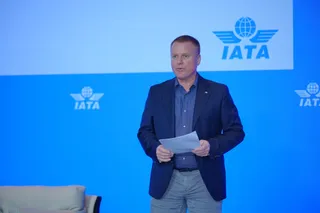DESDEMONA - Research and Innovation Do Pay Off
Contact Our Team
For more information about how Halldale can add value to your marketing and promotional campaigns or to discuss event exhibitor and sponsorship opportunities, contact our team to find out more
The Americas -
holly.foster@halldale.com
Rest of World -
jeremy@halldale.com

Chris Long takes looks at a multi-nation developed simulator now used for specialised UPRT training.
Pure research may not always create an immediately productive result, and often applied research falls short of a commercially viable product. Confounding that view is an ambitious research programme born in Europe - Desdemona has matured to the point at which it has recently been used for Upset Prevention and Recovery Training (UPRT) by the first commercial airline customer, a VVIP flight operator based in the Gulf.
Origins
Way back in 1997 a new programme of investigation into Spatial Disorientation was started by AMST, the Austrian simulator manufacturer, and TNO, the primary research organisation of the Netherlands government. By 2002 funding was shared by various sources, with one third coming from TNO, representing the interests of the Royal Netherlands Air Force (RNLAF) and the Ministry of Economic Affairs, and AMST, which contributed two thirds of the finance.
The aim was to create a simulator which would deliver fully and unlimited gimbaling, and which would provide a platform which could generate sustained “g” and provide a “heave” capability, thereby emulating real forces felt by air force pilots. The project saw metal cut for the first time in 2003 and the facility was opened in 2007; the first research started towards the end of 2007.
Underlying Science
When considering what to build in order to simulate the range of physical forces imposed on any pilot flying in a vigorous flight regime, a critical factor needs to be a thorough understanding of the physiology involved.
Dr Eric Groen of the TNO centre at Soesterberg, 45 minutes south-east of Amsterdam, indicates that this base is a centre of study of Human Performance, and happily is close to the main aeromedical training centre of the RNLAF. The dual inputs of the deep understanding of human physiology and of the loads imposed on a pilot became an excellent start point. Groen is himself an expert on motion perception - how the body senses any form of motion - and Dr Mark Wentink of Desdemona BV, the company operating the Desdemona, is a specialist in motion cueing - how to prompt the body’s receptors to give realistic inputs.
The AMST contribution was led by Dr Michael Mayrhofer, who, as project director, oversaw the build up of partnerships to design and create a unique device. It was quickly realised that the standard hexapod motion platform as used by the normal simulators would not be capable of delivering the full range of essential motion cues. Consequently a fully gimbaled device was designed. The gimbal frame itself is mounted on a sledge, which can be manipulated on the main arm to allow control of eccentricity with respect to the main rotation. Thus the simulator, when turning, can even produce sustained “g”-loads. Additional electrical servo actuator pistons can also rapidly move the gimbal frame within the sledge in the vertical direction in order to reproduce the ‘heave” felt, for instance, during severe turbulence.
Not only did the hardware have to be developed, but the complex software to drive it needed to be refined. It was here that another dimension of international cooperation was added for the civilian applications. Partners from many countries and research organisations contributed skills, not least from Russia, where the renowned leading-edge aerodynamic research centres of Gromov and TsAGI in Zhukovsky made contributions to the team. Test pilots from major manufacturers (Boeing, Airbus), European cockpit associations, and aviation authorities (ICAO, EASA, IATA) supported the initiative while validating the novel out-of-the-certified-envelope flight model.
Applications
As the research progressed the device got to the point when its unique capabilities could be used in earnest. It now routinely provides training for RNLAF F-16 pilots, who can explore and learn recovery from departures - even including inverted spin or deep stall recovery, manoeuvres which would be too dangerous in the real aircraft. Still within the military, “Brown-out” training for the RNLAF Chinook pilots became an essential part of their desert operations after the loss of an aircraft because of this condition in Afghanistan.
Training for those wanting to go into space has also been delivered - not least to Bob Geldof - who lays claim to planning to be the first Irish Astronaut!
Civilian Training
The year of 2009 was, sadly, characterised by several loss of control (LOC-I) accidents involving civilian aircraft, and which resulted in heavy loss of life. Carrying out training beyond the stall in real airliners, with the associated non-normal aircraft behaviour, such as wing-drop, control reversal and potential loss of control, is evidently not feasible. In any case not all manufacturers go so deeply into that part of the flight regime, so detailed knowledge of that flight envelope is scarce.
Knowing the capabilities of Desdemona, Groen proposed the creation of the Simulation of Upset Recovery in Aviation (SUPRA) research programme. This time further development of aircraft class-representative flight models was obviously needed to accurately reflect typical aerodynamic characteristics of a large swept wing jet in those potentially uncharted flight regimes. Once again international cooperation resulted in a gradual refinement of the performance of Desdemona. It can now accurately produce a realistic and credible set of handling characteristics to replicate the extremes of airliner aerodynamic handling. Part of that process was the independent assessment by twelve experienced test pilots, all from an elite group who have either flown big aircraft in those situations, or been very close to it. Their feedback was that the device provided a very good representation of what the big aircraft really behaved and felt like when in those extreme circumstances.
It is here where Halldale had some small part to play. At the APATS 2014 conference in September, conference representatives of a VVIP flight in the Gulf heard the presentation made by Dr Mayrhofer, and very soon afterwards had booked a sequence of training for three pilots (including the post holder and training director) to assess the value of the Desdemona UPRT. Halldale was there to record the immediate impressions after the training had been delivered early in November.
Desdemona, a Unique UPRT Simulator
The training consisted of a one day course, with the theory of aerodynamic effects and spatial disorientation explained before an individual session in the Desdemona simulator. It was interesting to hear the enthusiasm with which the three pilots described their experience. Each had a slightly different take on it, but all greatly valued the training. One pilot found it greatly increased his confidence and, as a training captain, will significantly boost his credibility when he briefs and trains his fellow pilots in his company. Another was surprised by the exposure to genuine spatial disorientation - he was astonished by the fragility of the human senses in conditions that they were not designed for. There was huge value in realising how quickly one could be taken outside the comfort zone. All the pilots not only thought that the training was hugely worthwhile, but also emphasised that the whole sequence had been very enjoyable, and had greatly added to the sum of their aeronautical experience. One observation was that, where other devices are good at training both the recognition and prevention of upsets, they are less well adapted to showing the recovery element from extreme situations. This recovery training is the great strength of Desdemona.
Conclusion
This first training package was very effective. What was interesting is that the crews strongly suggested that the training be increased to a two day course, with extended briefing on the theory, coupled with more detailed briefing on the scenarios played out in the simulator. What we are talking about here is simply the fine tuning of a fascinating and effective programme.
Desdemona is a complex device, but it does hugely extend the range of UPRT. This currently unique device will never be able to deliver such training to the vast majority of commercial pilots, although without doubt lead trainers at airlines would benefit, but it does reinforce the drive to understand and train in an area which the industry is now addressing with considerable vigour.


.png/r%5Bwidth%5D=320/7f2021f0-9a0d-11f0-b8f7-272ce5993c28-nano-banana-2025-09-24T11-07-03%20(1).webp)